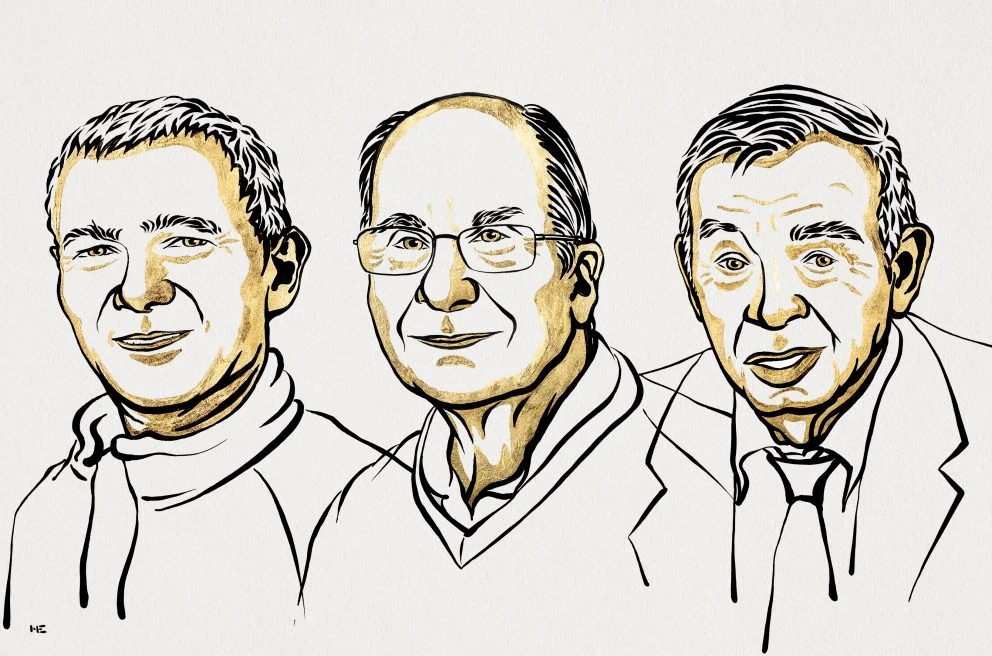Three boundary-pushing scientists receive the 2023 Nobel Prize in Chemistry
Their development of tiny "quantum dot" particles revolutionized LED and QLED technologies
Jenaye Johnson • October 4, 2023

Moungi Bawendi, Louis Brus and Alexei Ekimov were the recipients of the 2023 Nobel Prize in Chemistry [Credit: Niklas Elmehed © Nobel Prize Outreach]
Moungi Bawendi, Louis E. Brus, and Alexei Ekimov were jointly awarded this year’s Nobel Prize in Chemistry. The award was given for their development in the fundamentals of nanotechnology — namely, the discovery and chemical synthesis of quantum dots.
According to the Nobel Prize Committee, Ekimov and Brus independently created quantum dots within a few years of one another. Brus was also the first scientist to prove that quantum dots could emit colors based on their size while floating in a solution. Meanwhile, Bawendi was awarded for his contribution to developing a chemical mechanism that the Committee deemed a “nearly perfect production” of quantum dots in a special solvent.
Their separate work, when applied in tandem, has provided the chemical and technological foundations for modern-day computer monitors and TV screens, LED lights and biomedical tissue imaging. “These achievements represent an important milestone in nanotechnology,” noted Johan Åqvist, Chair of the Nobel Committee for Chemistry.
Quantum dots are extremely small particles. According to Heine Linke, Member of the Nobel Committee for Chemistry, the size of these nanoparticles relative to a soccer ball is the same scale as that of a soccer ball compared to the Earth. The particles are known for their thermal and electrical properties, such as their ability to shift in color. This happens when the size and number of the particles change. Then, they glow a myriad of colors, from red to green to blue.
Ekimov of Nanocrystals Technology Inc. was one of the early pioneers in the physicist-led theories surrounding particle size effects and quantum mechanics. His experiments with stained glass and copper chloride sparked a discovery. By adding copper chloride to glass, he showed that the reactions between the two created nanocrystals. Following this, he then demonstrated that the glass color was correlated with the size of the nanocrystal particle, completing the conception of a new class of materials.
In 1983, shortly after Ekimov’s success, Brus delivered another important discovery. Brus, a professor emeritus at Columbia University, looked at particles in a different context. He was interested in how solar light affected chemical reactions and noticed how particle color changed with size. He ultimately became the first scientist to replicate quantum dots’ changing colors as they floated freely in a liquid solution.
In the world of quantum mechanics, this discovery shed light on how electron waves — which can also be depicted by a color scale — store energy depending on size. The larger the nanoparticle’s wavelength, the redder the color when energy is finally released. As these dots become smaller, their colors start to shift across the visible light spectrum, until finally reaching the shortest wavelengths: violet.
However, the work of Ekimov and Brus was largely theoretical. A gap still remained between what could be done on small scales in a lab and real-world applications.
Bawendi was able to apply their theories to reality. Bawendi, a chemistry professor at the Massachusetts Institute of Technology specialized in electro-optics and biology at nano levels. According to Åqvist, his chemical method to precisely make quantum dots in well-controlled special solutions would prove to be groundbreaking.
In 1993, Bawendi invented a solvent method to control particle growth at its earliest stage. In doing so, he provided a new means to protect the surface of the particles while maintaining full control of their size and quality. Quantum dots were able to be used commercially as a result.
Bawendi noted that the larger scientific community realized the implications of this process in the 1990s. He also “didn’t think it would be me” in reference to winning the Nobel Prize, since so many scientists in the field had made important quantum discoveries.
Along with his two co-laureates, Bawendi is sure there are still more exciting advancements to be made with these nanoparticles, which are now widely used. “There’s a lot of work that’s still being done … about quantum effects of all sorts. The world will see in the future where it will go.”
1 Comment
That was a really great read and very informative. Thank you for sharing.